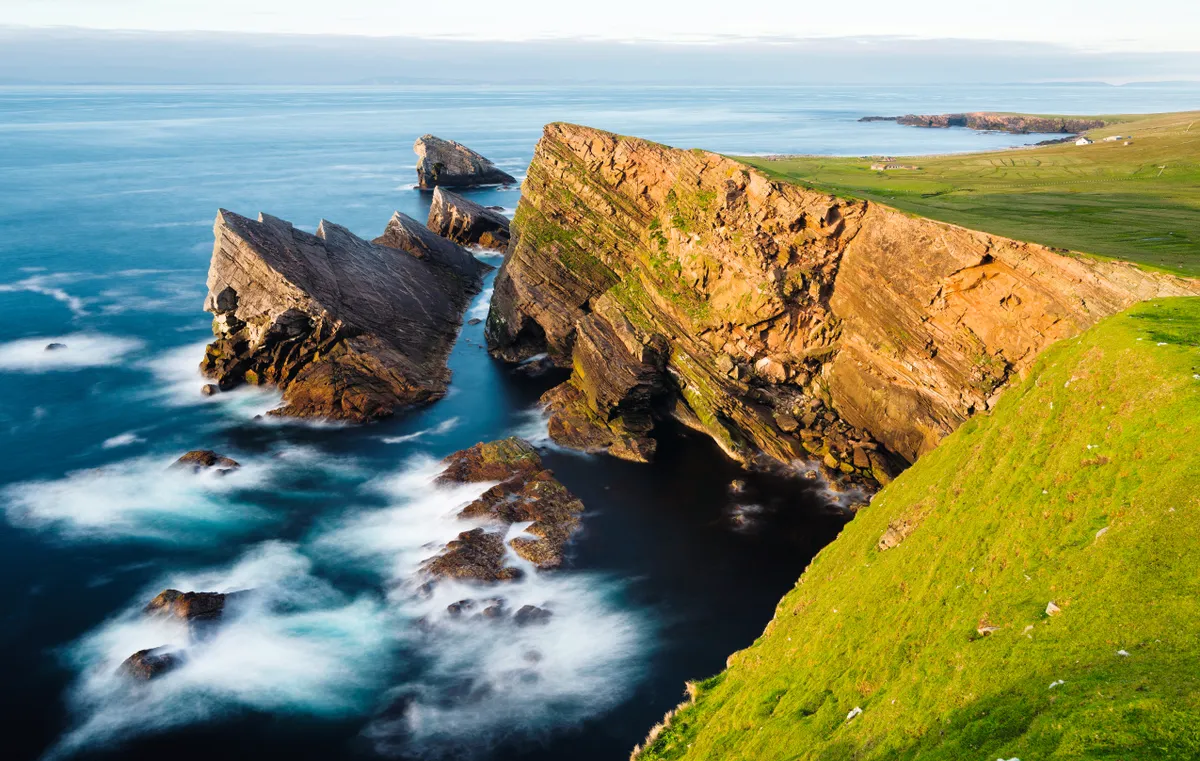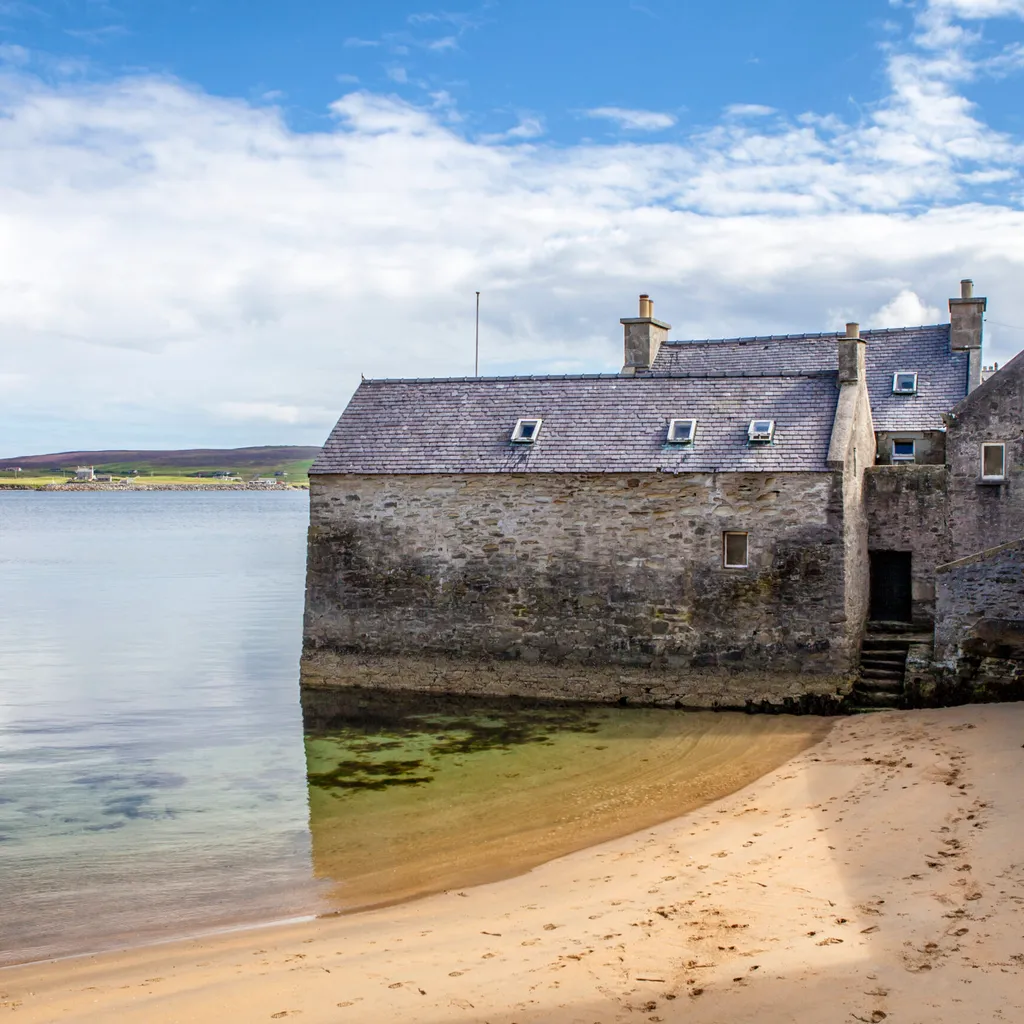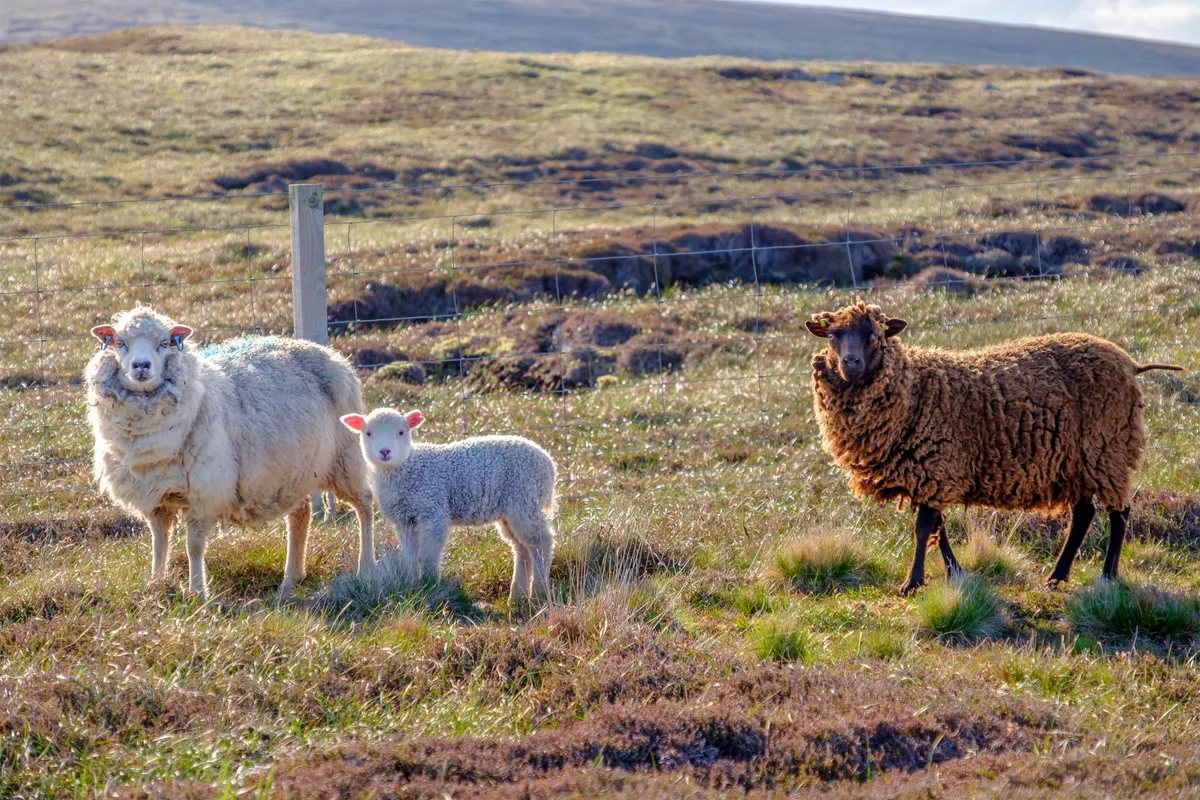Shetland, or the Shetland Islands, is a group of about 100 islands, 16 inhabited, located around 110 miles north of the Scottish mainland.
Almost half of Shetland’s population of 23,000 live in and around Lerwick, which is on the biggest island, known as Mainland. The two next biggest isles are Yell and Unst. Regular ro-ro ferries connect them.
Shetland is rugged, its ragged, 1,679-mile coastline punctuated by breathtaking beaches, making it one of the most beautiful island groups in the UK. Burra Isle and the South Mainland have glorious white sands, as do Yell, Unst and Northmavine. The cliffs range from (arguably) the highest sea cliff in Britain, on remote Foula, to the easily accessible array at Eshaness. Stand at the edge of the immense slash in the rock called Calder’s Geo, look down and you can see the entrance to Britain’s biggest sea cave.
Shetland is a place of extremes. People come for the remoteness, to be at the end of Britain. Once here, though, the world tilts on its axis and you start seeing everywhere else as far away from what is, after all, “the hilt of the sword”.
Discover everything you need to know about these far-flung islands with our beginner's guide to Shetland, including how to get there, places to visit, where to stay and eat, and island wildlife.

Where are the Shetland Islands?
Shetland is located around 110 miles north of the Scottish mainland. You are well on the way to the Faroe Islands, Iceland and Norway – the Shetland capital Lerwick is further north than Oslo – and the Scandinavian influence here is strong.
How do you get to the Shetland Islands?
How to get to Shetland by air
Loganair flies direct to Shetland from Glasgow, Edinburgh, Aberdeen and Orkney.
How to get to Shetland by sea
There are nightly NorthLink Ferries sailings from Aberdeen (twice a week via Orkney) to Lerwick, taking 12 to 14 hours. Cabins and sleeping pods are available.
What you are looking for is a calm, clear summer’s night, and preferably one of the 14-hour overnight sailings from Aberdeen via Orkney. Then, if you’re lucky, the ferry trip to Shetland will be a mini-cruise, including dolphins, orcas, a sighting of the Orcadian sea-stack called the Old Man of Hoy and a sailing into the ‘simmer dim’ – Shetland dialect for the midnight sun of midsummer, when twilight lingers through the short night.
The morning arrival in Lerwick never fails to touch the soul. True, sometimes a delayed, rough trip cannoning into a big north-easterly can bring a more physical relief when you finally step on to dry land, but watching the morning sun glitter off fishing boats as they hustle for landing space fairly warms the heart.

What is the population of the Shetland Islands?
Shetland has a population of 23,000 people, half of whom live in and around Lerwick, which is on the biggest island, known as Mainland.
Shetland, the TV series
The BBC TV crime drama Shetland has been a worldwide smash hit and attracted thousands of tourists to the isles. No visit to Lerwick is complete without viewing ‘Jimmy Perez’s House’: the wonderful Lodberry in Lerwick, now complete with an embedded ‘Hollywood’ star for actor Douglas Henshall.
In general the show is regarded with great affection, but occasional shrugs of mystification: why on Earth did they have to film that bit in Greenock? Why does the only native Shetland actor portray a bumbling buffoon? And most of all, that playing fast and loose with geography: you can’t walk across the St Ninian’s Isle tombolo and end up in Nesting!
But the cast and crew have made themselves very popular, their presence has brought financial benefit to the isles, and they’ve been sensitive to local concerns, on the whole. Except, no, you definitely cannot see Norway from Lerwick!
History and heritage of Shetland
The name itself comes from Viking days: the Old Norse ‘Hjaltland’ is generally thought to mean ‘the hilt of a sword’. The Vikings displaced most of the native Picts in AD900, and Shetland only became part of Scotland in the 15th century. Up Helly Aa, an annual series of fire festivals marking the start of winter’s slippage into spring, celebrates the Viking heritage with galley-burning and committed partying into the night and beyond dawn.
Shetland wildlife
On Shetland’s shores, the birds are glorious in their variety and occasionally scary. Bonxies (great skuas) will attack if they think you are a threat. The autumn rarities that come fluttering, such as ruffs, little stints and curlew sandpipers bring groups of enthusiastic birdwatchers, and occasionally the kind of mass twitch that sees chartered planeloads of birders arrive, all camouflaged lenses and Gore-Tex.
And then there are the sea mammals. Seals, porpoises, dolphins and whales bring with them a sense of wonder at nature’s sheer power.

Walking in Shetland
Lerwick waterfront and Clickimin Broch
4 miles; 2 hours
From Victoria Pier in Lerwick, head along the least-modernised part of Commercial Street with its lodberries (stone stores built into the sea). Follow the coast to the cemetery, then up to Knab promontory for incredible views. Stay on the coast to Tesco; cross the road to the preserved Clickimin Pictish Broch. Walk on the main road back to start.
Eshaness and Grind o’ da Navir
4–6 miles; 2–3 hours
Easily accessible by car – park at Eshaness Lighthouse – this is a classic walk that is safe and easy if the weather is good and you stay away from cliff edges. The scenery is spectacular – walk north along the coast to the Grind, a natural amphitheatre.
Places to visit in Shetland
When you have finished wandering the wild shores and hills of Shetland, there is plenty more to see and do. For such a small population, the arts scene and other facilities are impressive. The arrival of oil in the 1970s brought wealth both individually and collectively. There are eight modern leisure centres with swimming pools if you fancy a dip indoors, and there are award-winning museums plus a state-of-the-art cinema and performance complex called Mareel in Lerwick. But it’s sometimes the almost complete absence of potholes on the roads that impresses visitors most.
Here are a few ideas to get you started:
Calder’s Geo
From Calder’s Geo, look down and you can see the entrance to Britain’s biggest sea cave, thought to be some 20 metres tall and covering 5,600 square metres. Few have ever been inside, as the sea conditions make access only possible for the intrepid.
The Shetland Museum and Archives Hay’s Dock
Just along from Mareel, the boat hall and outdoor seafaring exhibits at Shetland Museum & Archives are wonderful. There's a very good shop and café, too.
Bonhoga Gallery Weisdale
In a former mill, Bonhoga has permanent and touring exhibitions of both local and international work, with a pleasant café.
Hoswick Visitor Centre
Hoswick Visitor Centre is a really interesting community-run craft and cultural centre. Yet another wonderful café.
Fethaland
Wherever you go, the sea is nearly always within sight and sound. The most poignant memorial to its role in Shetland life – its power to bereave and enrich – is perhaps found at Fethaland, a long walk in from the road-end at North Roe, in the north of Mainland. This was once Shetland’s busiest haaf (deep-sea) fishing station, from where men would spend entire springs and summers heading up to 40 miles out to sea in open boats to fish. Now the tiny stone booths they lived in are deserted, but an outcrop of soapstone (steatite) bears some of those fishermen’s initials, and the dates they spent here. There’s one from 1866, sharp and clear as the knife that carved it.

Shetland Textile Museum Lerwick
Shetland Textile Museum Lerwick is located in the Böd of Gremista. An old fishing booth, some of the classic Fair Isle designs are gathered here.
Sumburgh Head Lighthouse
Explore the history and natural heritage of Sumburgh Head from Iron Age settlers to today. And, of course, the lighthouse itself. Shetland’s only German café is here.
Jarlshof Prehistoric Settlement
Near Sumburgh Airport are the remarkable ruins of Jarlshof, a settlement that was occupied for almost 4,000 years, since around 2700 BC through Norse times.
The brochs
Mousa is the best preserved Pictish broch (roundhouse) in Europe; regular ferries go to the island.
Scalloway Castle, Mainland
A wonderfully spooky ruin, once the centre of power in Shetland. The community-run Scalloway Museum is next door.

Unst
The island of Unst has more archaeological sites per square mile than almost anywhere else in Britain, and yet its remoteness makes it less visited. Start with the restored Viking longhouse and the longship Skipbladner.
Clickimin
Clickimin is easy to find in Lerwick, and there are ruined broch sites throughout the isles.
Best places to stay in Shetland
Sumburgh Head Lighthouse
You can stay in the former keeper’s quarters at several of Shetland’s lighthouses – Bressay and Eshaness especially – but Sumburgh Head really is the last word. Self-catering for five people in three luxurious bedrooms. Cosy, grand and quite awesomely positioned. From £96 for one night.
Busta House Hotel, Brae
Busta House Hotel comes with its very own ghost (a grey lady, one of many in Scotland). This 16th-century (much extended) mansion is quirky, luxurious and comes with its own lovely gardens and harbour. Great food and one of the best collections of single malt whisky in the isles. From £115 for a double room.
Westshore, Mainland
A self-catering cottage like nowhere else in Shetland, Westshore is cutting-edge architecture married to the walls of an ancient crofthouse. Stunning outside and in, there are views across Vaila Sound. From £500 for five nights.
Best places to eat and drink
The Peerie Shop Café, Lerwick
The Peerie Shop Cafe has great daytime coffee, home-made scones, cakes and spectacular soups and sandwiches. A real institution and one you’ll want to linger in.
Frankie’s Fish and Chips, Brae
Winner of several national awards, Frankie's fish comes from a single boat and the menu includes mussels, scallops and a host of other offshore goodies. Takeaway, or there’s an outdoor terrace and you can reserve an indoor table in advance. Not licensed.
St Magnus Bay Hotel, Hillswick
St Magnus Bay Hotel is a place of generous hospitality, a warm welcome and huge portions. The Sunday lunchtime carvery is legendary. Afternoon tea is also a wonder to behold.
The Dowry, Lerwick
The Dowry is a great modern café bar with ‘small plates’ of local food in the evenings. Splendid for coffee but a good selection of beers and wines, too.
The Lounge Bar, Lerwick
Head up the stairs to the Lounge’s lounge. Wednesday evenings are the best for sessions by or with local musicians. The downstairs public bar is more – how can I put this? – uncompromising.
Traditional Shetland food
I could mention the great local dishes – reestit mutton soup, bannocks, cod cheeks, herring in oatmeal – but I’ll just say that, in summer, the best of Shetland food is to be found at the Sunday community-hall teas. Fancies (homebakes), pies, that aforementioned soup, bannocks of all sizes, and often crafts on sale, too. Look for adverts in The Shetland Times, online at shetnews.co.uk or on noticeboards. shetlandtimes.co.uk
Shetland economy
Fishing and fish-farming still provide good work for Shetlanders; as do oil and gas, so there is little unemployment. Farming, in the Highland form of smallholding called crofting, is a major activity – though usually combined with some other form of work.
Look out for the native Shetland sheep: it is small, hardy and produces, from its belly, a wool so fine that it can be worn next to the skin. The first successful Everest expedition was equipped with Shetland wool gansies (jumpers) and you can still buy an Everest sweater today. Shetland sheep are also renowned for the taste and quality of their meat; the lamb or mutton from the animals that feed on shoreline seaweed is a taste never to be equalled or forgotten.
Discover Shetland's knitwear
Traditional knitwear is still widely produced and is one of the major aspects of the tourism industry, with the annual Shetland Wool Week attracting thousands of visitors in late September, many armed with knitting needles. This annual celebration of all things woollen offers talks, workshops, tours and events to suit knitters of all skill levels. There are also online events and an archive of free patterns available. At other times of the year, Misa Hay runs a series of knitting-themed tours and events around the island throughout the year, as well as producing the Shetland Wool Adventures Journal.

Are there trees on Shetland?
Trees. People always mention the absence of them from Shetland, but it's hard not to love the sightlines, the vastness of the skies, from the ‘steekit stumbas’ (foggy autumn days with low red suns) to the harsh snaps of winter and the summer’s endless light. Besides, the woodlands at Kergord on Mainland, Halligarth on Unst and elsewhere prove there are trees in Shetland.
Traditional Shetland music and dance
Music, particularly traditional fiddling, remains a big part of Shetland’s cultural life, and the Wednesday and weekend session at Lerwick’s legendary Lounge Bar provide plenty of tuneful action. Serious players and beginners alike can learn from the best at the regular events – notably the Shetland Folk Festival in spring and the Shetland Accordion and Fiddle Festival every October.
The Boston two-step, the islands’ favourite dance, can leave strong men and women ‘spaegied’ (weak and aching) for a week after taking part.

